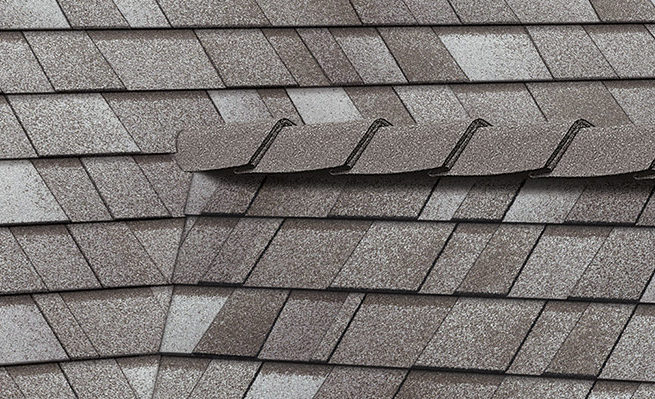
Roof shingles are a frequent type of roof covering which consists of individual overlaying rudiments. These rudiments are generally flat blockish shapes that are laid in an overlaying series starting from the subordinate edge of the roof upwards, with each following row lapping with the joints below. Shingles are generally made with fiberglass, saturated with asphalt, and also covered in minerals to help repel weathering. Have you ever wondered how shingles are formed? You know, the things on top of your roof that cover your home. We all have them, but we clearly do not know about them much. When asphalt shingles became famous in the early 1900s, they were only obtainable in two colors: green and black. Today, regardless, asphalt shingles come in a wide assortment of colors, from definitive black to natural earth styles and modern reds, blues, and greens. Modern shingle roofing can also be textured to look like slate, wood, or tile making the roof safer and lower maintenance without sacrificing style. Roofing shingles come in a variety of accoutrements and have been redesigned and evolved over the years. Getting the proper shingle choice that will withstand storms and professional roofers for your roof installation is important in guarding your home and assets against the rudiments.
Tar, which is the binder in the asphalt shingle has been utilized for thousands of years. It was used to leakproof the liners of conduits and between bricks. By the 1950s the asphalt shingle looked really much like it does today. The roof liner started out as organic felt but finding anon-organic material was a must to support with fire averting and weight issues. Asbestos was a material that was set up to work well, still, latterly it was discovered that it poses serious health issues. now we use a fiberglass mat is used as the base material for the shingles. Fiberglass is perfect material as it's fire resistant and truly rugged to the elements. Another term for Asphalt shingles is compound shingles. The foundation base of the shingle is made of wood and paper or fiberglass. Fiberglass is preferred as it's fire resistant but also lighter weight. This mat is also covered in tar which is from naturally being deposits or a derivate of crude oil refining. Once the foundation is covered, fly ash or finely ground limestone is adjoined. This material acts as a stabilizer and makes the shingles further durable and fire resistant.
Once the shingles are through that process, ceramic sheeted mineral grains are added to the top. These can be in a diversity of colors and help with UV defense from the sun. This further increases the shingles fire- resistant power as well as adjoining an enchanting finish. Shingles that are used in places of high moisture may have a bit of copper appended to them to help cease the growth of algae. The rear of the shingles is covered in some talc or sand to keep the shingles from fully sticking together. And, spots or strips of thermoplastic glue is added. Once the shingles are installed the heat of the sun will warm this glue giving them a bit more grip. When it comes to producing shingles, the procedure comes into three parts. First is assembling the raw accoutrements, also producing those accoutrements, and then finishing by packaging and delivering the finished products upon completion. The raw accoutrements it takes to produce shingles are either organic felt or fiberglass, which is base down to a water- grounded pulp formed into sheets that are dried, cut into strips, and wound onto rolls. These rolls are also oxidized and chemically treated to deliver a final shingle product through manufacturing.
In the manufacturing process, asphalt shingles are formed by passing the base material through a machine that adds consecutive component layers. This procedure begins by dry looping, which takes a jumbo roll of organic felt or fiberglass mat and pressing it through a dry looper. Also, the base raw material goes through a pre-saturation chamber where it's scattered on one side with hot asphalt to get relieve of any humidity present. The material is also soaked in the asphalt coats to fill the gap between the fleece and the mat. This is succeeded by wet looping when the asphalt coating on the mat cools down to produce a lesser degree of saturation. With the asphalt coating stabilized by pulverized minerals, the mat will also pass- through coating rolls which are separated by an applicable distance to ensure an acceptable quantum of coating asphalt is applied to the mat.
After the coating process, grains of ceramic-coated minerals of the asked color are applied to the mat’s exterior. The sheet of treated mat will also pass through a series of breakers that put the coating patches into the asphalt and cool off the material. The strip of finished shingle raw material is also put into a cutting machine to cut it into asked shapes and sizes. This entire procedure is complete with the slice of the shingles to proper size as well as their tabs. The tabs assist interlock the shingles and cover them from the wind. Once the process is whole there's some derivate from it. This derivate can be of ends of shingles and the cutouts from the tabs. All of the derivations are generally sold to the asphalt road paving companies. This option, due the weight, doesn’t always make the utmost sense. But, if the shops are near to each other, it does work well for both.
Are you conceivably viewing shingles as your material of choice? Whether you're looking for shingles particularly or just want to get your roof changed, our company can assist you get your roof looking good as new. Our platoon of largely experienced roofers are experts in all things roofing-related.
Reach out to us at Goldenberg Roofing NYC 1247 5th Avenue New York NY 10029 https://bestroofingnyc.com/.